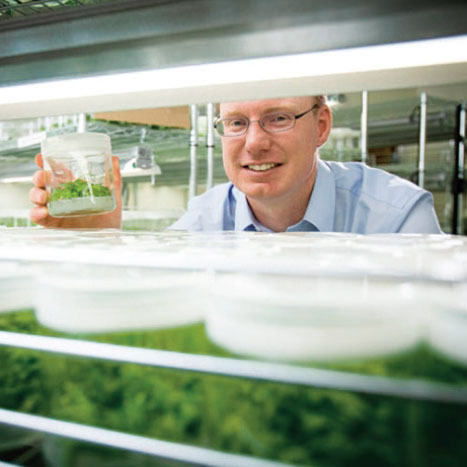Water and time are money if you’re a farmer. Trees are especially slow, and to get a new apple variety growing at a commercial scale can take years. It not only takes a couple of years after planting for fruit production to start, but it’s a long time just getting trees to plant.
The number of trees needed to plant a commercial-scale orchard is daunting. Even a small orchard of 100 acres needs nearly a quarter million trees to get going. And while it might take only a couple years to “raise a few rootstocks, thousands can take many years,” Washington State University apple breeder Kate Evans says.
If you placed an order for trees today—forking over about 25 percent of the total cost as a deposit—you might get your trees in three years. But more likely it’ll be five years. In the meantime, you’re not growing anything and you’re not making any money.
A startup called Phytelligence is disrupting that status quo. Founded in 2012 by Amit Dhingra, an associate professor of horticulture at WSU, and a group of his graduate students, the company is working with an innovative technology that means they can deliver millions of trees in a year to 18 months. Couple that with an extraordinary savings in water, a guarantee of the tree being true to type, and the company is poised to be, well, the next Apple of apples…and almonds, grapes, cherries, pears, and much more.
The innovation, at first glance, sounds old hat: Phytelligence is basically growing trees in gelatin in Mason jars. Called tissue culture, it’s a technique that has been a lab standard for a century. But most commercial nurseries that employ tissue culture are using an old one-size-fits-all recipe that was developed to grow one of the lab rats of plant science, tobacco.
It turns out that by customizing the growth medium—the gelatin at the bottom of the Mason jar—and controlling a few other variables in ways apples or other crops find conducive to growth, things speed up. A lot.
A commercial apple tree is almost always a combination of two different kinds of apple. The fruit-bearing part is called the scion. The scion is grafted to a rootstock. Kevin Hauser of Kuffel Creek Nursery in Riverside, California, says, “It’s like joining the brains of a scientist to the legs of an athlete.” Rootstocks do a lot for the fruit tree, including conferring disease resistance, drought tolerance and, critically, they don’t grow very tall. A short tree is a tree that doesn’t demand as many inputs—water, nutrients, chemicals. In other words, it’s a tree that saves growers money.
With conventional production of rootstock, there’s several years’ worth of consumables before the tree gets to the orchard. A young tree is pushed over onto its side so that its branches dive into the soil, forming new roots. The next spring, the whole mass is dug up and separated into individual trees. Over a period of years, this process is repeated many times until the desired number of rootstocks is available. Scions are produced in similar fashion.
Phytelligence saves 50 to 100 gallons of water for every tree they produce, says Tyson Koepke ’12 PhD. One of the company’s founders, Koepke runs Phytelligence’s Pullman operation.
Phytelligence also uses its genomics expertise to guarantee its rootstocks are true to type. Dhingra’s lab was one of the core members of an international team that sequenced the apple genome. They’ve since sequenced the genomes of many other crops. They use this genetic know-how to ensure that they’re delivering what the customer ordered.
If you order dwarfing rootstock, but then discover that you actually got semi-dwarfing trees, you have a major problem. As Koepke says, “Farmers can’t afford to replant because of errors like that.”
So great has the demand been that Phytelligence has expanded well beyond its original Pullman operation. They’ve leased a 200,000-square-foot greenhouse facility in Burien, near Seattle, that has a six- to eight-million-plant capacity.
The family that owned and operated Bel-R Nurseries in Burien were, after three generations, looking to retire. Mike Rastelli ’83 and his wife, Jodee ’83, met Dhingra and decided that Phytelligence would be a good fit for the facility. “It turned out to be two Cougar families melding together,” Rastelli says.
“These greenhouses were built with love,” Dhingra says. Rastelli’s grandfather and father built the greenhouses over a period of years, expanding capacity as the ornamental plant market rapidly expanded after World War II.
The company also leased a vast tissue culture facility just outside Portland. The original setup in Pullman now serves as a germplasm repository and research lab.
Phytelligence’s move into the new digs was well timed. They’ve already sold out their spring 2017 plant production as demand continues to grow. With the expansion of Phytelligence’s leadership team to include Tim Zenk ’84 as vice president of new business, horizons are expanding, too.
Focused on the world’s other two major fruit producers, Zenk says, “China and India have antiquated systems, old trees, and national goals to increase fruit production. The only way to do that is plant new trees.”


